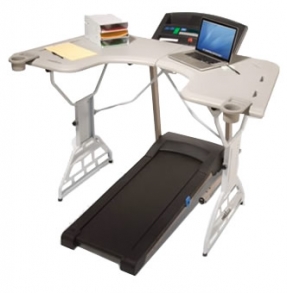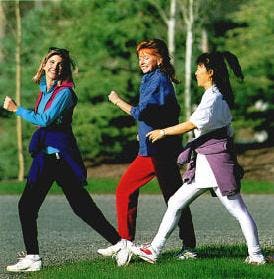With all due respect to The Proclaimers, the folks at Horizon Software International have walked 11,102 miles and far from falling down at anyone’s door (see the song lyrics) they’re climbing stairs, shedding pounds, and talking as they’re walking.
That talking thing there is a big plus. It’s just what Julie Denmon was hoping for when she pitched senior management on WalkingSpree‘s fitness program. That was 48,940,815 steps ago.
“Who knew,” she says, “that a walking program would coax cubicle dwellers to get up and go talk with their team members, instead of emailing across the office?” Just as she expected, people are losing weight, they’re much less sedentary, and, as she hoped, there is “Definitely more team collaboration and more social interactions. I personally witness every day at lunch, our employees walking the property.”
Sitting leads to earlier dying
“I’ve never had so many people come into my office,” says Denmon, who’s office manager for the 140 employee company that specializes in developing software for food service operations. “They come in and tell me how many pounds they’ve lost. And they’re talking to each other.”
That’s a happy consequence of a program developed to improve the fitness of office workers. Study after study shows that sedentary office workers are more likely to have health problems than active workers. In the most extensive and authoritative study of office workers ever done, researchers found that the longer workers sat, the more likely they were to die.
Of the 822 who told researchers in 1981 that they sat almost all the time, almost 20 percent were dead by 1994. Of the 3,000 who said they “almost never” sat, just under 7 percent were dead.
Peter Katzmarzyk, one of the leading researchers in the field of exercise science and medicine and lead author of the study published in 2009, said bluntly, “What we generally see is that people who sit more during the day have a higher risk of dying from any cause, and in particular, mortality from heart disease.”
Over the years, as the evidence in favor of exercise as a way to improve worker health mounted, insurers took notice and began to offer incentives for employers to provide wellness programs. The most visible benefits to an employer come from two places: savings on premiums as a company’s claims decrease, and reduced sick time.
Health-focused benefits becoming more common
Among Silicon Valley’s high tech firms it’s not at all unusual for companies to offer health club memberships, on-site gyms, massage services, and yoga classes. Health-focused benefits are becoming increasingly common everywhere. And vendors have responded with programs as simple as walking programs and health monitoring websites, to include even office furniture. For $479 TrekDesk will sell you a standup desk to wraparound your treadmill so you can burn calories while burning the midnight oil.
classes. Health-focused benefits are becoming increasingly common everywhere. And vendors have responded with programs as simple as walking programs and health monitoring websites, to include even office furniture. For $479 TrekDesk will sell you a standup desk to wraparound your treadmill so you can burn calories while burning the midnight oil.
American Financial Group considered subsidized gym memberships, but after considering how easy it is to join and never go, opted for WalkingSpree. It’s program, launched in 2008, came up with an ROI of $9 an employee. It’s a calculated ROI, based on studies of lost productivity, workers comp, and health care costs. However, at the end of the first year the company’s employees (2,700 participated) had such improved medical results that AFG’s health premiums barely increased.
Denmon says it’s too early for Horizon to know it’s return on investment. She suspects, that like the social interaction benefit, it will be positive. At a cost of only $99 for each of the 83 participating employees (plus a few more dollars for incentive prizes), it isn’t an expensive program.
Getting a ninefold return on the investment would be a happy result, but that wasn’t her first thought when she happened upon the program last year. She was scouting locations for the company’s annual user conference when she asked the rep showing her around about the pedometer on his belt and discovered WalkingSpree.
“I was very intrigued to say the least,” explains Denmon, who said it wasn’t hard selling senior management on the program. In fact, she says, Randy Eckel, Horizon’s president, is one of the company’s Top Walkers and lately he’s been averaging 19,000 steps a day, an impressive 9 miles.
An easy to implement program
WalkingSpree is easy to implement. The technical parts are all turnkey. At Horizon, employees bought the pedometer to track their steps. Each gets a personal, private web space where they can record medical information, set health goals and see how they compare to the company. Denmon gets reports on the walking indivdiuals and groups do.
Like all programs, there’s a certain amount of cheerleading to get it started and periodic contests to keep up enthusiasm. Next month Horizon is competing against a Chicago software to see which company will log the most steps.
This month, the campaign is “Avoid the Elevators. “Our company is divided between two floors and I have seen a tremendous increase in stair use,” Denmon says. “I even designed a t-shirt for this specific campaign. Of course you have to win the shirt with various challenges during the month.”
